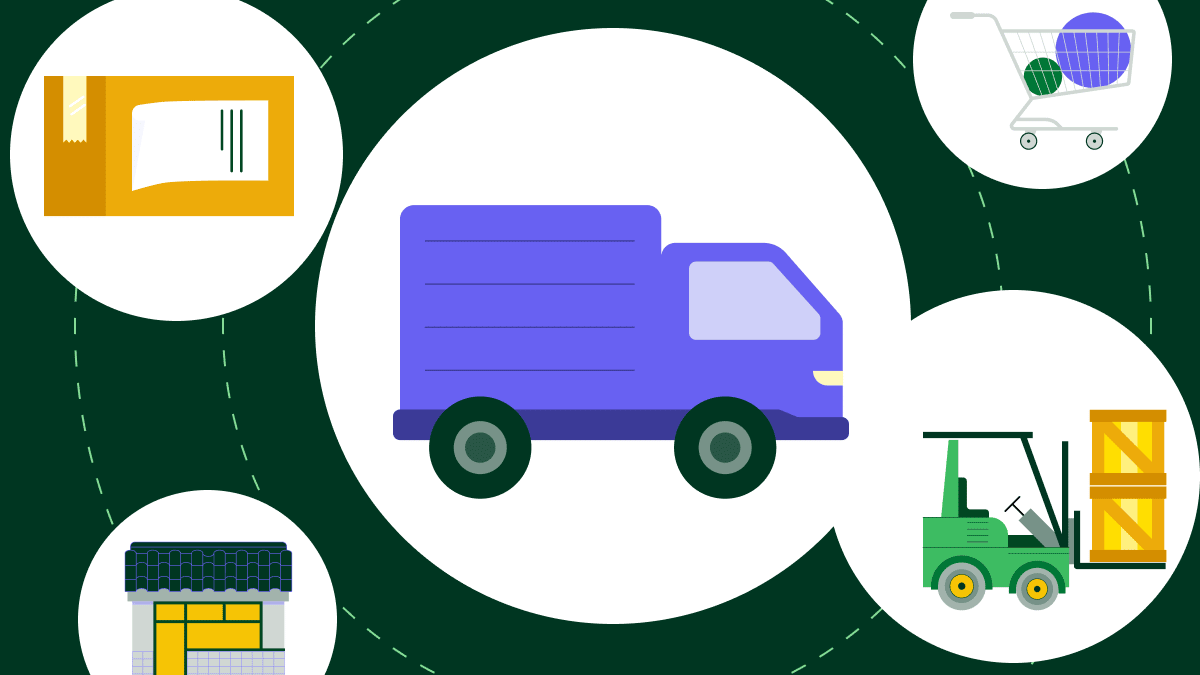Selling is one of the most critical business functions because it drives revenue. A strong sales team builds relationships with prospects and persuades them to buy a product.
In our The state of sales and marketing 2025: The economy review report, we discovered a clear link between sales success and company growth. Companies that grew their revenue in 2024 were seven times more likely to have a successful sales team than one failing to hit its quotas.
The big challenge in sales is figuring out how to do it effectively. What sales strategies can you use for your particular product? What qualities do you need to sell well?
In this article, we’ll explain what sales is and define a number of related sales terms. We’ll also explain the basics of making your sales process more effective and explore how to set up a robust sales system.
Key takeaways from the sales article
- Sales is the critical, revenue-driving function defined by structured activities that persuade prospects to complete a transaction.
- Effective selling relies on using repeatable methodologies (such as SPIN or Challenger) and on possessing key traits like empathy and data-driven analysis.
- Pipedrive is best because it’s the CRM sales managers trust to track data, manage teams, and drive performance by centralizing productivity tools
Sales definition: What is sales?
The best definition of sales is the exchange of money for goods or services. However, in business, it is defined as is a set of activities a business does to help customers buy their product. These actions vary from company to company but often include:
Prospecting and generating new leads
Developing buyer personas (with marketing)
Qualifying leads
Conducting product demonstrations
Building personal connections with clients (relationship selling)
Writing product proposals
Negotiating prices and contract terms
Completing orders and transactions
Upselling and cross-selling
Handing customers off to customer success teams
Sales also refers to the team of people responsible for sales activities. The ultimate goal of sales teams is to generate revenue and drive the growth of a business.
Companies don’t always refer to sales as “sales” and you may hear it referred to as different things. Another word for sales is “commerce”, while “selling” can also be used. Additionally, you can use a term like “transactions”, “trade”, or “retail” as another word for sales.
Most companies follow a specific methodology or trusted sales process. A sales plan ensures sales reps stay focused on nurturing leads down the buying journey and don’t waste resources on needless tasks.
Sales example
Imagine a small SaaS (software as a service) company that offers a project management software tool.
The sales department identifies potential clients through various means like using sales lead generation tools, attending networking events or receiving website inquiries.
After meeting a potential customer at an industry event for software companies, a sales representative enters the customer’s information into their customer relationship management (CRM) tool. The lead then goes through the sales pipeline.
The next step they take is to schedule a discovery call with the prospect to understand their project management challenges. The rep then demonstrates the product to show how it addresses the customer’s needs.
After the demonstration, the sales rep uses the CRM to take notes and schedule follow-up emails at the right time. Then they ask the prospect whether the product meets their needs.
The prospect is convinced but asks the sales rep to meet with additional stakeholders: their team leader and a few team members. At this point, the rep prepares to address several potential objections.
Eventually, the team is convinced and they start negotiating the contract terms. All parties agree to a subscription plan and make their first payment, completing the sale (sometimes called a conversion when transactions happen online).
After that, the sales representative engages the customer in after-sales activities, connecting the client with the customer success team.
Sales vs. marketing
Sales and marketing are two complementary but distinct business functions.
Marketing operates at the beginning of the customer journey, creating awareness and demand for a company, product or service.
The marketing department owns activities like:
Market research
Advertising
Digital marketing
Content creation
Social media engagement
Public relations
Event planning
Marketing teams are responsible for generating high-quality leads through a well-designed website landing page with a CTA (call-to-action) to book a product demonstration.
They might also work with sales teams on projects such as creating buyer personas or sales enablement content material. Once a person becomes a lead, sales teams take over to uncover their specific needs, show the product’s value and facilitate the purchase.
For example, after marketing identifies a lead, sales would be responsible for giving demos and following up with prospects.
What is sales in marketing?
Sales in marketing refers to the strategic alignment of promotional and relationship-building activities that turn customer awareness and interest into closed deals and revenue. Sales is the transfer of a product from the manufacturer to the customer in exchange for money, while marketing is understanding the customer’s needs and introducing a product.
Marketing manages the upper funnel by creating demand and generating qualified leads through advertising, content and brand building. Sales then handles these qualified leads in the lower funnel through direct, personalized efforts such as product demonstrations, negotiation and relationship selling to convert interest into a final transaction. Effective collaboration between these two teams, often referred to as Smarketing, is crucial for achieving growth, as it ensures a seamless customer journey and a unified strategy focused on enhancing the company’s profitability.
In simple words: Sales is giving the product to the customer for money and marketing is finding out what the customer needs and showing them the right product
Sales vs. customer support
Sales and customer support teams have many overlapping priorities, like keeping people happy.
They differ in where they take charge of the customer journey: sales focuses on the customer experience before making a sale and customer support jumps in after the sale.
Customer support’s role is to resolve issues. Their activities include:
Responding to customer inquiries
Addressing customer complaints
Providing technical support
Collecting customer feedback
Updating knowledge bases
It’s important sales and customer support work together to create a smooth transition.
For example, say the sales team has just closed on a new client. After the first few weeks, the client gets back in touch, asking how to integrate an existing tool with the new platform. Sales would call on customer support to explain the integration process and help troubleshoot.
Sales vs. customer success
Similar to customer support, customer success (CS) teams take over after the sales team completes a sale. They are responsible for the later stages in the customer journey: increasing retention and encouraging advocacy.
Customer success managers are responsible for activities like:
Following up with customers to maximize the value they get from the product
Sharing onboarding and training materials
Ensuring customers know how to use crucial features
Providing advice on best practices using a product
Helping with subscription renewals
Collecting customer feedback
Identifying customers at risk of churning and proactively address those risks
Customer success teams are evaluated on metrics like customer satisfaction, retention rates and upselling or cross-selling revenue.
For example, say the sales team has closed a deal with a client on a new project management platform. A customer success manager would immediately contact the client’s team to kick off a tailored training program so everyone knows how to use the platform.
Sales teams focus on acquiring new customers, while CS teams focus on retaining customers and maximizing their value over time.
Types of sales
Sales types fall into categories based on the nature of the transaction, the type of customer, the sales environment and the sales approach.
Here are common terms you’ll hear in the industry.
B2B sales
Business-to-business (B2B) sales happens when one business sells products or services to another.
For example, QuickBooks provides cloud-based accounting software for small and medium-sized businesses, so it engages in B2B sales.
B2C sales
Business-to-consumer (B2C) sales involves selling products or services directly to individual consumers.
For example, Airbnb is a marketplace offering short-term homestays to individual customers, so they do B2C sales.
Product sales
Product sales refers to selling tangible products like clothes, electronics, software or food.
For example, Framery sells soundproof pods and booths for office spaces. Those booths are physical products, so Framery does product sales.
Service sales
Service sales is selling intangible products or services such as consulting services, insurance policies or gym memberships.
For example, PwC offers strategic business consultancy, so its sales team engages primarily in service sales.
Consultative sales
In consultative selling, you put building relationships with customers first. The priority is developing a complete understanding of the customer’s pain points. Once you understand customer needs, you can offer your product as a solution.
A consultative sales approach can create a longer sales cycle than other sales techniques but it is effective in generating repeat customers. This method is common in industries with complex or high-value products or services.
Consultative sales is also called needs-based sales.
Direct sales
Direct sales is when you sell a product or service directly to the end-user without any middlemen.
For instance, an e-commerce site that sells clothes directly to consumers and not to retail stores is involved in direct sales.
Indirect sales
Indirect sales is when you sell your product or service through distributors or resellers.
An example of indirect sales is an electronics manufacturer that sells smartphones to a department store, which then sells them to consumers.
Inside sales vs. outside sales
The difference between inside sales and outside sales is where the selling takes place.
With inside sales, sales reps do not meet customers face-to-face. They contact prospective customers remotely, often via phone, email or video conferencing. This approach is common in the software and technology industries.
For example, a marketing agency that contacts potential clients via email is doing inside sales.
Outside sales refers to sales made through face-to-face interactions with customers. It often involves traveling to meet clients in person and giving presentations or product demos.
For example, a real estate agent selling houses to clients in person engages in outside sales.
Agency sales
Agency sales is a sales arrangement where one company hires another company to sell its products or services. These external agencies receive a commission or fee for each sale they make.
For instance, insurance companies often use an agency sales model. They might contract independent agents to sell insurance policies to customers. The agents do not purchase the policies themselves but sell them on behalf of the insurance company and receive a commission for each policy sold.
Enterprise sales
Enterprise sales involves selling products or services to large businesses or organizations. These are typically complex, high-value sales and involve multiple decision-makers or stakeholders within the client organization.
An example of enterprise software sales would be a software company selling management consulting services to a large corporation.
Account management
Account management focuses on nurturing relationships with clients. Account management aims to maximize value for the customer so they continue to use your services over time.
Effective account management goes beyond the sales team. It includes collaborating with other teams (like operations, customer success and customer support) to meet customer needs.
Sales 101: Methodologies
Sales methodologies guide sales teams with repeatable sales processes. They help salespeople identify prospects, engage with them and close deals.
Here are some common and effective sales methodologies.
SPIN selling
SPIN stands for situation, problem, implication and need payoff. SPIN selling involves asking questions to understand:
The customer’s current situation
Their problems
The implications of those problems
The benefits that would come from solving the problems
The methodology was proposed by Neil Rackham after studying more than 35,000 sales calls. Rackham found that when you ask prospects the right questions at the right time, you can truly understand their needs. This helps you better explain how your product solves your prospects’ problems and sell more effectively.
The Challenger sales model
The Challenger sales model encourages salespeople to take charge of the conversation, challenge the customer’s preconceived notions and expand their thinking. The focus is teaching customers something new.
Matthew Dixon and Brent Adamson proposed the model in their book The Challenger Sale: Taking Control of the Customer Conversation. They explain that good challenger salespeople are great teachers who can help prospects see value and opportunities they may not have noticed before.
The Challenger model is especially effective when selling products with complex features.
Solution selling
Solution selling focuses on understanding the customer’s pain points, challenges and goals to provide tailored solutions. In solution selling, sales reps try to position their product as the answer to the customer’s needs.
Solution Selling is a concept by Michael Bosworth, who studied the top sellers at Xerox. He argued that solution selling could be a powerful alternative to conventional sales techniques.
Bosworth proposed six steps to Solution selling:
Understanding the product or service
Identifying prospect pain points
Asking selling questions
Educating the prospect
Demonstrating the product’s value
Closing the sale
The Sandler selling system
The Sandler selling system is a sales methodology developed by David Sandler in the 1960s. It emphasizes a low-pressure and consultative approach to selling. This method aims to generate long-term success rather than short-term sales.
The Sandler selling system has seven steps:
Establishing bonding and building rapport
Setting an up-front contract
Identifying the prospect’s pain points
Uncovering the prospect’s budget
Identifying the decision-making process
Presenting the full agreement
Confirming the post-sales process
Throughout the process, the focus is to build trust and create a collaborative relationship with the prospect. It encourages active listening and effective communication to address the prospect’s pain points and get results that benefit everyone.
SNAP selling
Jill Konrath developed SNAP selling to help sales professionals engage with overwhelmed and time-constrained buyers.
SNAP stands for:
Keep it Simple. Make your sales process as easy as possible.
Be iNvaluable. Become a trusted partner.
Always Align. Understand prospects’ concerns and be prepared to answer them.
Raise Priorities. Keep the most important decisions at the top of their mind.
SNAP Selling recognizes that buyers today are inundated with information and have limited time available for decision-making. The framework helps sales professionals streamline their approach, provide relevant information and build meaningful relationships with buyers.
6 qualities of high-performance salespeople
Highly effective salespeople have several traits and skills in common that help them meet their quotas quarter after quarter. Develop these qualities to up your sales game.
1. Empathy and emotional intelligence
At its core, sales is about relationships. Successful salespeople understand the emotions and perspectives of their customers and can make personal connections.
The best sales reps empathize with their prospects’ challenges, needs and concerns and adapt their approach accordingly. Emotional intelligence helps them build rapport, establish trust and tactfully overcome sales objections.
2. Excellent communication skills
Good salespeople have strong communication skills. They can effectively articulate ideas, ask relevant questions and tailor their message to the needs and preferences of their audience.
3. Product knowledge
A good salesperson has in-depth knowledge of the product or service they’re selling. They understand its features, benefits and value proposition.
Complete knowledge of the product helps you find the right fit for the customer’s needs and demonstrate its value to customers effectively.
4. Goal-oriented and results-driven
Successful salespeople set clear sales goals for themselves. They know what they want to achieve, whether it’s a monthly revenue target or securing a certain number of new clients. Clear goals help sales associates stay focused and prioritize their tasks.
Results-driven salespeople also find goals motivating. They want to surpass targets, close deals and drive revenue growth. The satisfaction and sense of accomplishment derived from achieving results fuel their drive and help them stay productive.
5. Fluency with sales tools
A good salesperson knows how to use their sales tools. They are comfortable navigating and leveraging CRM systems to:
Track leads
Record customer interactions
Manage sales pipelines
Update deal stages
Send automatic reminder follow-up emails to prospects
Notify customer success teams when a deal closes
Top reps use automation tools to streamline repetitive tasks and analyze CRM data to prioritize tasks smarter. Fluency with sales tools enhances productivity, organization and the ability to deliver a seamless sales experience.
6. Data-driven
Data provides insights that help sales organizations make better decisions. Sales data, customer behavior and market trends help salespeople identify patterns in sales and understand customer preferences. Data-driven sales reps can also use forecasts to identify fruitful new opportunities.
Data also enables objective evaluations of sales performance. For example, insights and reports on key performance indicators (KPIs), like conversion rates, average deal size or sales velocity can uncover areas for improvement.
Data-driven decision-making minimizes guesswork and helps sales teams continuously improve their performance.
Sales managers will use a CRM tool like Pipedrive to track data and manage teams. CRMs help sales reps easily see and analyze their productivity or compare performance.
Common questions about sales
Sales is a multifaceted and complex discipline. Here are some common questions new sales reps have when starting out.
Final thoughts
It’s hard to understate the importance of a well-oiled sales machine – it is critical for business growth.
Well-functioning sales processes effectively communicate, persuade and demonstrate value to potential customers. To become a top sales professional, find the sales methodologies that work best for your industry, learn to make your sales software work for you and deliver exceptional customer experiences.
Upgrade your skills by working through a sales training program. Understand sales fundamentals and use proven sales strategies to unlock your sales potential and contribute to your company’s success.










